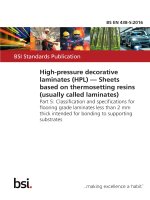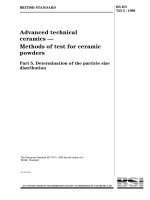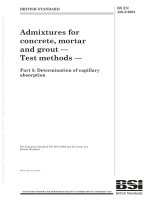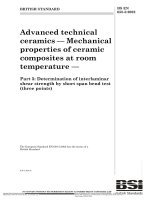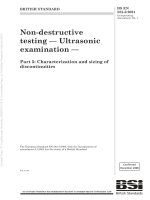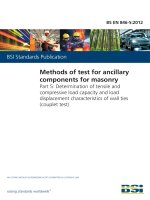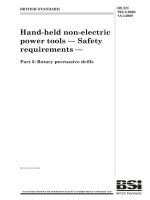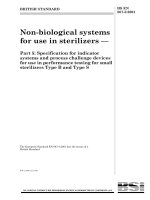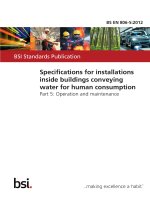Bsi bs en 61784 5 17 2013
Bạn đang xem bản rút gọn của tài liệu. Xem và tải ngay bản đầy đủ của tài liệu tại đây (1.3 MB, 28 trang )
BS EN 61784-5-17:2013
BSI Standards Publication
Industrial communication
networks — Profiles
Part 5-17: Installation of fieldbuses —
Installation profiles for CPF 17
BRITISH STANDARD
BS EN 61784-5-17:2013
National foreword
This British Standard is the UK implementation of EN 61784-5-17:2013. It is
identical to IEC 61784-5-17:2013.
The UK participation in its preparation was entrusted to Technical Committee AMT/7, Industrial communications: process measurement and
control, including fieldbus.
A list of organizations represented on this committee can be obtained on
request to its secretary.
This publication does not purport to include all the necessary provisions of
a contract. Users are responsible for its correct application.
© The British Standards Institution 2014.
Published by BSI Standards Limited 2014
ISBN 978 0 580 84202 3
ICS 25.040.40; 35.100.40
Compliance with a British Standard cannot confer immunity from
legal obligations.
This British Standard was published under the authority of the
Standards Policy and Strategy Committee on 31 January 2014.
Amendments/corrigenda issued since publication
Date
Text affected
BS EN 61784-5-17:2013
EN 61784-5-17
EUROPEAN STANDARD
NORME EUROPÉENNE
EUROPÄISCHE NORM
December 2013
ICS 25.040.40; 35.100.40
English version
Industrial communication networks Profiles Part 5-17: Installation of fieldbuses Installation profiles for CPF 17
(IEC 61784-5-17:2013)
Réseaux de communication industriels Profils Partie 5-17: Installation des bus de terrain
- Profils d'installation pour CPF 17
(CEI 61784-5-17:2013)
Industrielle Kommunikationsnetze Profile Teil 5-17: Feldbusinstallation Installationsprofile für die
Kommunikationsprofilfamilie 17
(IEC 61784-5-17:2013)
This European Standard was approved by CENELEC on 2013-10-22. CENELEC members are bound to comply
with the CEN/CENELEC Internal Regulations which stipulate the conditions for giving this European Standard
the status of a national standard without any alteration.
Up-to-date lists and bibliographical references concerning such national standards may be obtained on
application to the CEN-CENELEC Management Centre or to any CENELEC member.
This European Standard exists in three official versions (English, French, German). A version in any other
language made by translation under the responsibility of a CENELEC member into its own language and notified
to the CEN-CENELEC Management Centre has the same status as the official versions.
CENELEC members are the national electrotechnical committees of Austria, Belgium, Bulgaria, Croatia, Cyprus,
the Czech Republic, Denmark, Estonia, Finland, Former Yugoslav Republic of Macedonia, France, Germany,
Greece, Hungary, Iceland, Ireland, Italy, Latvia, Lithuania, Luxembourg, Malta, the Netherlands, Norway, Poland,
Portugal, Romania, Slovakia, Slovenia, Spain, Sweden, Switzerland, Turkey and the United Kingdom.
CENELEC
European Committee for Electrotechnical Standardization
Comité Européen de Normalisation Electrotechnique
Europäisches Komitee für Elektrotechnische Normung
CEN-CENELEC Management Centre: Avenue Marnix 17, B - 1000 Brussels
© 2013 CENELEC -
All rights of exploitation in any form and by any means reserved worldwide for CENELEC members.
Ref. No. EN 61784-5-17:2013 E
BS EN 61784-5-17:2013
EN 61784-5-17:2013
-2-
Foreword
The text of document 65C/738/FDIS, future edition 1 of IEC 61784-5-17, prepared by
SC 65C "Industrial networks" of IEC/TC 65 "Industrial-process measurement, control and automation"
was submitted to the IEC-CENELEC parallel vote and approved by CENELEC as
EN 61784-5-17:2013.
The following dates are fixed:
•
latest date by which the document has to be
implemented at national level by
publication of an identical national
standard or by endorsement
(dop)
2014-07-22
•
latest date by which the national
standards conflicting with the
document have to be withdrawn
(dow)
2016-10-22
This standard is to be used in conjunction with EN 61918:2013.
Attention is drawn to the possibility that some of the elements of this document may be the subject of
patent rights. CENELEC [and/or CEN] shall not be held responsible for identifying any or all such
patent rights.
Endorsement notice
The text of the International Standard IEC 61784-5-17:2013 was approved by CENELEC as a
European Standard without any modification.
BS EN 61784-5-17:2013
EN 61784-5-17:2013
-3-
Annex ZA
(normative)
Normative references to international publications
with their corresponding European publications
The following documents, in whole or in part, are normatively referenced in this document and are
indispensable for its application. For dated references, only the edition cited applies. For undated
references, the latest edition of the referenced document (including any amendments) applies.
NOTE When an international publication has been modified by common modifications, indicated by (mod), the relevant EN/HD
applies.
Annex ZA of EN 61918:2013 applies, except as follows:
Publication
Year
Title
EN/HD
Year
EN 61918
2013
Addition to Annex ZA of EN 61918:2013:
IEC 61918
2013
Industrial communication networks Installation of communication networks in
industrial premises
–2–
BS EN 61784-5-17:2013
61784-5-17 © IEC:2013
CONTENTS
INTRODUCTION ..................................................................................................................... 7
1
Scope ............................................................................................................................... 8
2
Normative references ....................................................................................................... 8
3
Terms, definitions and abbreviated terms ......................................................................... 8
4
CPF 17: Overview of installation profiles .......................................................................... 8
5
Installation profile conventions ......................................................................................... 8
6
Conformance to installation profiles .................................................................................. 9
Annex A (Normative) CP 17/1 (RAPIEnet) specific installation profile................................... 10
A.1 Installation profile scope ................................................................................................. 10
A.2 Normative references ..................................................................................................... 10
A.3 Installation profile terms, definitions, and abbreviated terms ........................................... 10
A.3.1 Terms and definitions ............................................................................................ 10
A.3.2 Abbreviated terms ................................................................................................. 10
A.3.3 Conventions for installation profiles ....................................................................... 10
A.4 Installation planning ....................................................................................................... 10
A.4.1 General ................................................................................................................. 10
A.4.1.1
Objective .............................................................................................. 10
A.4.1.2
Cabling in industrial premises ............................................................... 10
A.4.1.3
The planning process ............................................................................ 10
A.4.1.4
Specific requirements for CPs ............................................................... 10
A.4.1.5
Specific requirements for generic cabling in accordance with
ISO/IEC 24702 ...................................................................................... 10
A.4.2 Planning requirements ........................................................................................... 10
A.4.2.1
Safety ................................................................................................... 10
A.4.2.2
Security ................................................................................................ 10
A.4.2.3
Environmental considerations and EMC ................................................ 10
A.4.2.4
Specific requirements for generic cabling in accordance with
ISO/IEC 24702 ...................................................................................... 11
A.4.3 Network capabilities .............................................................................................. 11
A.4.3.1
Network topology .................................................................................. 11
A.4.3.2
Network characteristics ......................................................................... 11
A.4.4 Selection and use of cabling components .............................................................. 12
A.4.4.1
Cable selection ..................................................................................... 12
A.4.4.2
Connecting hardware selection ............................................................. 14
A.4.4.3
Connections within a channel/permanent link ........................................ 15
A.4.4.4
Terminators .......................................................................................... 16
A.4.4.5
Device location and connection ............................................................. 16
A.4.4.6
Coding and labelling ............................................................................. 16
A.4.4.7
Earthing and bonding of equipment and devices and shielded
cabling .................................................................................................. 16
A.4.4.8
Storage and transportation of cables ..................................................... 17
A.4.4.9
Routing of cables .................................................................................. 18
A.4.4.10 Separation of circuit .............................................................................. 18
A.4.4.11 Mechanical protection of cabling components ....................................... 18
BS EN 61784-5-17:2013
61784-5-17 © IEC:2013
–3–
A.4.4.12 Installation in special areas ................................................................... 18
A.4.5 Cabling planning documentation ............................................................................ 19
A.4.5.1
Common description ............................................................................. 19
A.4.5.2
Cabling planning documentation for CPs ............................................... 19
A.4.5.3
Network certification documentation ...................................................... 19
A.4.5.4
Cabling planning documentation for generic cabling in accordance
with ISO/IEC 24702............................................................................... 19
A.4.6 Verification of cabling planning specification ......................................................... 19
A.5 Installation implementation ............................................................................................. 19
A.5.1 General requirements ............................................................................................ 19
A.5.1.1
Common description ............................................................................. 19
A.5.1.2
Installation of CPs ................................................................................. 19
A.5.1.3
Installation of generic cabling in industrial premises .............................. 19
A.5.2 Cable installation ................................................................................................... 19
A.5.2.1
General requirements for all cabling types ............................................ 19
A.5.2.2
Installation and routing .......................................................................... 20
A.5.2.3
Specific requirements for CPs ............................................................... 20
A.5.2.4
Specific requirements for wireless installation ....................................... 20
A.5.2.5
Specific requirements for generic cabling in accordance with
ISO/IEC 24702 ...................................................................................... 21
A.5.3 Connector installation ............................................................................................ 21
A.5.3.1
Common description ............................................................................. 21
A.5.3.2
Shielded connectors ............................................................................. 21
A.5.3.3
Unshielded connectors .......................................................................... 21
A.5.3.4
Specific requirements for CPs ............................................................... 21
A.5.3.5
Specific requirements for generic cabling in accordance with
ISO/IEC 24702 ...................................................................................... 21
A.5.4 Terminator installation ........................................................................................... 21
A.5.5 Device installation ................................................................................................. 21
A.5.5.1
Common description ............................................................................. 21
A.5.5.2
Specific requirements for CPs ............................................................... 21
A.5.6 Coding and labelling .............................................................................................. 21
A.5.6.1
Common description ............................................................................. 21
A.5.6.2
Specific requirements for CPs ............................................................... 21
A.5.7 Earthing and bonding of equipment and devices and shield cabling ....................... 21
A.5.7.1
Common description ............................................................................. 21
A.5.7.2
Bonding and earthing of enclosures and pathways ................................ 21
A.5.7.3
Earthing methods .................................................................................. 21
A.5.7.4
Shield termination methods ................................................................... 22
A.5.7.5
Specific requirements for CPs ............................................................... 22
A.5.7.6
Specific requirements for generic cabling in accordance with
ISO/IEC 24702 ...................................................................................... 22
A.5.8 As-implemented cabling documentation ................................................................. 22
A.6 Installation verification and installation acceptance test .................................................. 22
A.6.1 General ................................................................................................................. 22
A.6.2 Installation verification ........................................................................................... 22
A.6.2.1
General ................................................................................................. 22
A.6.2.2
Verification according to cabling planning documentation ...................... 22
A.6.2.3
Verification of earthing and bonding ...................................................... 22
A.6.2.4
Verification of shield earthing ................................................................ 22
–4–
BS EN 61784-5-17:2013
61784-5-17 © IEC:2013
A.6.2.5
Verification of cabling system ................................................................ 22
A.6.2.6
Cable selection verification ................................................................... 23
A.6.2.7
Connector verification ........................................................................... 23
A.6.2.8
Connection verification .......................................................................... 23
A.6.2.9
Terminators verification ......................................................................... 23
A.6.2.10 Coding and labelling verification ........................................................... 23
A.6.2.11 Verification report ................................................................................. 23
A.6.3 Installation acceptance test ................................................................................... 23
A.6.3.1
General ................................................................................................. 23
A.6.3.2
Acceptance test of Ethernet based cabling ............................................ 23
A.6.3.3
Acceptance test of non-Ethernet-based cabling ..................................... 24
A.6.3.4
Specific requirements for wireless installation ....................................... 24
A.6.3.5
Acceptance test report .......................................................................... 24
A.7 Installation administration ............................................................................................... 24
A.8 Installation maintenance and installation troubleshooting ............................................... 24
Figure 1 – Standards relationships .......................................................................................... 7
Table A.1 – Network characteristics for balanced cabling based on Ethernet ........................ 11
Table A.2 – Network characteristics for optical fibre cabling .................................................. 12
Table A.3 – Information relevant to copper cable: fixed cables .............................................. 13
Table A.4 – Information relevant to copper cable: cords ........................................................ 13
Table A.5 – Information relevant to optical fibre cables ......................................................... 14
Table A.6 – Connectors for balanced cabling CPs based on Ethernet ................................... 14
Table A.7 – Optical fibre connecting hardware ...................................................................... 15
Table A.8 – Relationship between FOC and fibre types (CP 17/1) ......................................... 15
Table A.9 – Parameters for balanced cables ......................................................................... 19
Table A.10 – Parameters for silica optical fibre cables .......................................................... 20
BS EN 61784-5-17:2013
61784-5-17 © IEC:2013
–7–
INTRODUCTION
This International Standard is one of a series produced to facilitate the use of communication
networks in industrial control systems.
IEC 61918:2013 provides the common requirements for the installation of communication
networks in industrial control systems. This installation profile standard provides the
installation profiles of the communication profiles (CP) of a specific communication profile
family (CPF) by stating which requirements of IEC 61918 fully apply and, where necessary, by
supplementing, modifying, or replacing the other requirements (see Figure 1).
For general background on fieldbuses, their profiles, and relationship between the installation
profiles specified in this standard, see IEC 61158-1.
Each CP installation profile is specified in a separate annex of this standard. Each annex is
structured exactly as the reference standard IEC 61918 for the benefit of the persons
representing the roles in the fieldbus installation process as defined in IEC 61918 (planner,
installer, verification personnel, validation personnel, maintenance personnel, administration
personnel). By reading the installation profile in conjunction with IEC 61918, these persons
immediately know which requirements are common for the installation of all CPs and which
are modified or replaced. The conventions used to draft this standard are defined in Clause 5.
The provision of the installation profiles in one standard for each CPF (for example
IEC 61784-5-17 for CPF 17), allows readers to work with standards of a convenient size.
Figure 1 – Standards relationships
–8–
BS EN 61784-5-17:2013
61784-5-17 © IEC:2013
INDUSTRIAL COMMUNICATION NETWORKS –
PROFILES –
Part 5-17: Installation of fieldbuses –
Installation profiles for CPF 17
1
Scope
This part of IEC 61784-5 specifies the installation profiles for CPF 17 (RAPIEnet 1).
The installation profiles are specified in the annex. This annex is read in conjunction with
IEC 61918:2013.
2
Normative references
The following documents, in whole or in part, are normatively referenced in this document and
are indispensable for its application. For dated references, only the edition cited applies. For
undated references, the latest edition of the referenced document (including any
amendments) applies.
IEC 61918:2013, Industrial communication networks – Installation of communication networks
in industrial premises
The normative references of IEC 61918:2013, Clause 2, apply.
3
Terms, definitions and abbreviated terms
For the purpose of this document, the terms, definitions and abbreviated terms of
IEC 61918:2013, Clause 3, apply.
4
CPF 17: Overview of installation profiles
CPF 17 consists of one communication profile as specified in IEC 61784-2.
The installation requirements for CP 17/1 (RAPIEnet) are specified in Annex A.
5
Installation profile conventions
The numbering of the clauses and subclauses in the annexes of this standard corresponds to
the numbering of IEC 61918 main clauses and subclauses.
The annex clauses and subclauses of this standard supplement, modify, or replace the
respective clauses and subclauses in IEC 61918.
Where there is no corresponding subclause of IEC 61918 in the normative annexes in this
standard, the subclause of IEC 61918 applies without modification.
———————
1
RAPIEnet is a trade name of LSIS. This information is given for the convenience of users of this document and
does not constitute an endorsement by IEC of the trademark holder or any of its products. Compliance to this
profile does not require use of the trade name RAPIEnet. Use of the trade name RAPIEnet requires permission
of the trade name holder.
BS EN 61784-5-17:2013
61784-5-17 © IEC:2013
–9–
The annex heading letter represents the installation profile assigned in Clause 4. The annex
heading number shall represent the corresponding numbering of IEC 61918.
EXAMPLE
“Subclause A.4.4” in IEC 61784-5-17 means that CP 17/1 specifies the subclause 4.4 of IEC 61918.
All main clauses of IEC 61918 are cited and apply in full unless otherwise stated in each
normative installation profile annex.
If all subclauses of a (sub)clause are omitted, then the corresponding IEC 61918 (sub)clause
applies.
If in a (sub)clause it is written
IEC 61918 (sub)clause does not apply.
“Not
applicable.”,
then
the
corresponding
If in a (sub)clause it is written “Addition:”, then the corresponding IEC 61918 (sub)clause
applies with the additions written in the profile.
If in a (sub)clause it is written “Replacement:”, then the text provided in the profile replaces
the text of the corresponding IEC 61918 (sub)clause.
NOTE
A replacement can also comprise additions.
If in a (sub)clause it is written “Modification:”, then the corresponding IEC 61918 (sub)clause
applies with the modifications written in the profile.
If all (sub)clauses of a (sub)clause are omitted but in this (sub)clause it is written
“(Sub)clause × has addition:” (or “replacement:”) or “(Sub)clause x is not applicable.”, then
(sub)clause x becomes
valid
as
declared
and
all
the
other
corresponding
IEC 61918 (sub)clauses apply.
6
Conformance to installation profiles
Each installation profile within this standard includes part of IEC 61918:2013. It may also
include defined additional specifications.
A statement of compliance to an installation profile of this standard shall be stated 2 as either
Compliance to IEC 61784-5-17:2013 3 for CP 17/m<name> or
Compliance to IEC 61784-5-17 (Ed.1.0) for CP 17/m <name>
where the name within the angle brackets < > is optional and the angle brackets are not to be
included. The m within CP 17/m shall be replaced by the profile number 1.
NOTE
The name can be the name of the profile, for example RAPIEnet.
If the name is a trade name then the permission of the trade name holder shall be required.
Product standards shall not include any conformity assessment aspects (including quality
management provisions), neither normative nor informative, other than provisions for product
testing (evaluation and examination).
———————
2
In accordance with ISO/IEC Directives
3
The date should not be used when the edition number is used.
– 10 –
BS EN 61784-5-17:2013
61784-5-17 © IEC:2013
Annex A
(Normative)
CP 17/1 (RAPIEnet) specific installation profile
A.1
Installation profile scope
Addition:
This standard specifies the installation profile for Communication Profile CP 17/1 (RAPIEnet).
The CP 17/1 is specified in IEC 61784-2.
A.2
Normative references
A.3
Installation profile terms, definitions, and abbreviated terms
A.3.1
Terms and definitions
A.3.2
Abbreviated terms
A.3.3
Conventions for installation profiles
Not applicable.
A.4
Installation planning
A.4.1
General
A.4.1.1
Objective
A.4.1.2
Cabling in industrial premises
A.4.1.3
The planning process
A.4.1.4
Specific requirements for CPs
Not applicable.
A.4.1.5
A.4.2
A.4.2.1
Specific requirements for generic cabling in accordance with ISO/IEC 24702
Planning requirements
Safety
A.4.2.1.1
General
A.4.2.1.2
Electric safety
A.4.2.1.3
Functional safety
A.4.2.1.4
Intrinsic safety
A.4.2.1.5
Safety of optical fibre communication systems
A.4.2.2
Security
A.4.2.3
Environmental considerations and EMC
BS EN 61784-5-17:2013
61784-5-17 © IEC:2013
– 11 –
A.4.2.3.1
Description methodology
A.4.2.3.2
Use of the described environment to produce a bill of material
A.4.2.4
A.4.3
Specific requirements for generic cabling in accordance with ISO/IEC 24702
Network capabilities
A.4.3.1
Network topology
A.4.3.1.1
Common description
A.4.3.1.2
Basic physical topologies for passive networks
Not applicable.
A.4.3.1.3
Basic physical topologies for active networks
A.4.3.1.4
Combination of basic topologies
Not applicable.
A.4.3.1.5
Specific requirements for CPs
Not applicable.
A.4.3.1.6
A.4.3.2
Specific requirements for generic cabling in accordance with
ISO/IEC 24702
Network characteristics
A.4.3.2.1
General
A.4.3.2.2
Network characteristics for balanced cabling not based on Ethernet
Not applicable.
A.4.3.2.3
Network characteristics for balanced cabling based on Ethernet
Replacement:
Table A.1 provides values based on the template given in IEC 61918:2013, Table 2.
Table A.1 – Network characteristics for balanced cabling based on Ethernet
Characteristic
CP 17/1
Supported data rates (Mbit/s)
Supported channel length (m)
100, 1 000
b
100
Number of connections in the channel (max.)
Patch cord length (m)
a,b
a
Channel class per ISO/IEC 24702 (min.)
4
See IEC 61918:2013, Clause 4 and ISO/IEC 24702
b
Cable category per ISO/IEC 24702 (min.)
Class D
c
5
Connecting HW category per ISO/IEC 24702 (min.)
5
Cable types
Application dependent
a
See A.4.4.3.2
b
For the purpose of this table the channel definitions of ISO/IEC 24702 are applicable.
c
Additional information is available in IEC 61156 series.
BS EN 61784-5-17:2013
61784-5-17 © IEC:2013
– 12 –
A.4.3.2.4
Network characteristics for optical fibre cabling
Replacement:
Table A.2 provides values based on the template given in IEC 61918:2013, Table 3.
Table A.2 – Network characteristics for optical fibre cabling
CP 17/1
Optical fibre type
Single mode silica
Description
Bandwidth (MHz) or equivalent at λ (nm)
–
Minimum length (m)
0
Maximum length
Multimode silica
Connecting hardware
See A.4.4.2.5
Modal bandwidth (MHz × km) at λ (nm)
500 at 1 300
Minimum length (m)
0
a
(m)
2 000
Maximum channel insertion loss/optical power budget (dB)
3
Connecting hardware
See A.4.4.2.5
Modal bandwidth (MHz × km) at λ (nm)
–
Minimum length (m)
–
a
(m)
–
Maximum channel insertion loss/optical power budget (dB)
–
Connecting hardware
–
Modal bandwidth (MHz × km) at λ (nm)
–
Minimum length (m)
–
Maximum length
a
10 000
2
Maximum length
Hard clad silica
(m)
Maximum channel insertion loss/optical power budget (dB)
Maximum length
POF
a
a
(m)
–
Maximum channel insertion loss/optical power budget (dB)
–
Connecting hardware
–
This value us reduced by connections, splices and bends in accordance with formula (1) in 4.4.3.4.1 of
IEC 61918:2013.
A.4.3.2.5
Specific network characteristics
A.4.3.2.6
Specific requirements for generic cabling in accordance with
ISO/IEC 24702
A.4.4
Selection and use of cabling components
A.4.4.1
Cable selection
A.4.4.1.1
Common description
A.4.4.1.2
Copper cables
A.4.4.1.2.1
Balanced cables for Ethernet-based CPs
Replacement:
Table A.3 provides values based on the template given in IEC 61918:2013, Table 4.
BS EN 61784-5-17:2013
61784-5-17 © IEC:2013
– 13 –
Table A.3 – Information relevant to copper cable: fixed cables
Characteristic
CP 17/1
Nominal impedance of cable (tolerance)
100 Ω ± 15 Ω (IEC 61156-5)
DCR of conductors
Compliant to ISO/IEC 11801
DCR of shield
Compliant to ISO/IEC 11801
Number of conductors
4 or 8
Shielding
–
Colour code for conductor
WH, BU / YE, OG (if 4 conductors)
T568B (if 8 conductors)
Jacket colour requirements
–
Jacket material
–
Resistance to harsh environment (e.g. UV, oil resist, LS0H)
–
Agency ratings
–
Cable characteristics
In twisted pairs
Replacement:
Table A.4 provides values based on the template given in IEC 61918:2013, Table 5.
Table A.4 – Information relevant to copper cable: cords
Characteristic
CP 17/1
Nominal impedance of cable (tolerance)
100 Ω ± 15 Ω (IEC 61156-5)
DCR of conductors
Compliant to ISO/IEC 11801
DCR of shield
Compliant to ISO/IEC 11801
Number of conductors
4 or 8
Length
≤ 100m
Shielding
–
Colour code for conductor
WH, BU / YE, OG (if 4 conductors)
T568B (if 8 conductors)
Jacket colour requirements
–
Jacket material
–
Resistance to harsh environment (e.g. UV, oil resist, LS0H)
–
Agency ratings
–
Cable characteristics
In twisted pairs
A.4.4.1.2.2
Copper cables for non-Ethernet-based CPs
Not applicable.
A.4.4.1.3
Cables for wireless installation
A.4.4.1.4
Optical fibre cables
Replacement:
Table A.5 provides values based on the template given in IEC 61918:2013, Table 6.
BS EN 61784-5-17:2013
61784-5-17 © IEC:2013
– 14 –
Table A.5 – Information relevant to optical fibre cables
Characteristic
9..10/125 µm
single mode
silica
50/125 µm
multimode
silica
62,5/125 µm
multimode
silica
980/1 000 µm
step index POF
200/230 µm
step index hard
clad silica
Standard
IEC 60793-2-50,
Type B1
IEC 60793-2-10,
Type A1a
IEC 60793-2-10,
Type A1b
–
–
Attenuation per km
(650 nm)
–
–
–
–
–
Attenuation per km
(820 nm)
–
–
–
–
–
Attenuation per km
(1 310 nm)
≤ 0,5 dB/km
≤ 1,5 dB/km
≤ 1,5 dB/km
–
–
Number of optical
fibres
2
2
2
–
–
Jacket colour
requirements
User defined
User defined
User defined
–
–
Jacket material
User defined
User defined
User defined
–
–
Resistance to harsh
environment (e.g.
UV, oil resist, LS0H)
Application
dependent
Application
dependent
Application
dependent
–
–
A.4.4.1.5
Special purpose balanced and optical fibre cables
A.4.4.1.6
Specific requirements for CPs
Not applicable.
A.4.4.1.7
A.4.4.2
Specific requirements for generic cabling in accordance with
ISO/IEC 24702
Connecting hardware selection
A.4.4.2.1
Common description
A.4.4.2.2
Connecting hardware for balanced cabling CPs based on Ethernet
Replacement:
For CP 17/1 (RAPIEnet), the 8-way modular plug which is defined in IEC 60603-7 shall be
used at the AO. This connector at the AO is replacing the connector variants of TO defined in
ISO/IEC 24702.
Table A.6 provides values based on the template given in IEC 61918:2013, Table 7.
Table A.6 – Connectors for balanced cabling CPs based on Ethernet
IEC 60603-7 series
CP
17/1
a
IEC 61076-3106 b
IEC 61076-3117 b
IEC 61076-2101
IEC 61076-2109
shielded
unshielded
Var. 1
Var. 6
Var. 14
M12-4 with
D-coding
M12-8 with
X-coding
IEC 60603-7-3
or
IEC 60603-7-5
IEC 60603-7-2
or
IEC 60603-7-4
No
No
No
No
No
a
For IEC 60603-7 series, the connector selection is based on the desired channel performance.
b
Housings to protect connectors.
BS EN 61784-5-17:2013
61784-5-17 © IEC:2013
A.4.4.2.3
– 15 –
Connecting hardware for copper cabling CPs not based on Ethernet
Not applicable.
A.4.4.2.4
Connecting hardware for wireless installation
A.4.4.2.5
Connecting hardware for optical fibre cabling
Replacement:
Table A.7 provides values based on the template given in IEC 61918:2013, Table 9.
Table A.7 – Optical fibre connecting hardware
IEC 61754-2
IEC 61754-4
IEC 61754-24
BFOC/2,5
SC
No
No
CP 17/1
IEC 61754-20
IEC 61754-22
SC-RJ
LC
F-SMA
No
Yes
No
NOTE IEC 61754 series defines the optical fibre connector mechanical interfaces; performance specifications
for optical fibre connectors terminated to specific fibre types are standardised in IEC 61753-1 series.
Replacement:
Table A.8 provides values based on the template given in IEC 61918:2013, Table 10.
Table A.8 – Relationship between FOC and fibre types (CP 17/1)
Fibre type
9..10/125 µm
single mode
silica
50/125 µm
multimode silica
62,5/125 µm
multimode
silica
980/1 000 µm
step index POF
200/230 µm
step index hard
clad silica
BFOC/2,5
No
No
No
No
No
SC
No
No
No
No
No
SC-RJ
No
No
No
No
No
LC
Yes
Yes
Yes
No
No
F-SMA
No
No
No
No
No
FOC
A.4.4.2.6
Specific requirements for CPs
Not applicable.
A.4.4.2.7
A.4.4.3
Specific requirements for generic cabling in accordance with
ISO/IEC 24702
Connections within a channel/permanent link
A.4.4.3.1
Common description
A.4.4.3.2
Balanced cabling connections and splices for CPs based on Ethernet
A.4.4.3.2.1
Common description
A.4.4.3.2.2
Connections minimum distance
A.4.4.3.2.3
Balanced cabling splices
– 16 –
A.4.4.3.2.4
Balanced cabling bulkhead connections
A.4.4.3.2.5
Balanced cabling J-J adaptors
A.4.4.3.3
BS EN 61784-5-17:2013
61784-5-17 © IEC:2013
Copper cabling connections and splices for CPs not based on Ethernet
Not applicable
A.4.4.3.4
Optical fibre cabling connections and splices for CPs based on Ethernet
A.4.4.3.4.1
Common description
A.4.4.3.4.2
Optical fibre splices
A.4.4.3.4.3
Optical fibre bulkhead connections
A.4.4.3.4.4
Optical fibre J-J adaptors (optical fibre couplers)
A.4.4.3.5
Optical fibre cabling connections and splices for CPs not based on
Ethernet
Not applicable.
A.4.4.3.6
A.4.4.4
Specific requirements for generic cabling in accordance with
ISO/IEC 24702
Terminators
Not applicable.
A.4.4.5
Device location and connection
A.4.4.5.1
Common description
A.4.4.5.2
Specific requirements for CPs
Not applicable.
A.4.4.5.3
Specific requirements for wireless installation
Not applicable.
A.4.4.5.4
A.4.4.6
Specific requirements for generic cabling in accordance with
ISO/IEC 24702
Coding and labelling
A.4.4.6.1
Common description
A.4.4.6.2
Additional requirements for CPs
A.4.4.6.3
Specific requirements for CPs
Not applicable.
A.4.4.6.4
A.4.4.7
A.4.4.7.1
A.4.4.7.1.1
Specific requirements for generic cabling in accordance with
ISO/IEC 24702
Earthing and bonding of equipment and devices and shielded cabling
Common description
Basic requirements
BS EN 61784-5-17:2013
61784-5-17 © IEC:2013
– 17 –
A.4.4.7.1.2
Planner tasks
A.4.4.7.1.3
Methods for controlling potential differences in the earth system
A.4.4.7.1.4
Selection of the earthing and bonding systems
A.4.4.7.2
Bonding and earthing of enclosures and pathways
A.4.4.7.2.1
Equalisation and earthing conductor sizing and length
A.4.4.7.2.2
Bonding straps and sizing
A.4.4.7.2.3
Surface preparation and methods
A.4.4.7.2.4
Bonding and earthing
A.4.4.7.3
Earthing methods
A.4.4.7.3.1
Equipotential
Addition:
For CP 17/1 fieldbus networks, an equipotential earthing system shall be used.
A.4.4.7.3.2
Star
Not applicable.
A.4.4.7.3.3
Earthing of equipment (devices)
A.4.4.7.3.4
Copper bus bars
A.4.4.7.4
Shield earthing
A.4.4.7.4.1
Non-earthing or parallel RC
Not applicable.
A.4.4.7.4.2
Direct
Addition:
Shielding of bus cables shall always be connected to earth at both ends of the cables. Single
point shield termination shall be avoided.
A.4.4.7.4.3
Derivatives of direct and parallel RC
Not applicable.
A.4.4.7.5
Specific requirements for CPs
Not applicable.
A.4.4.7.6
A.4.4.8
Specific requirements for generic cabling in accordance with
ISO/IEC 24702
Storage and transportation of cables
A.4.4.8.1
Common description
A.4.4.8.2
Specific requirements for CPs
– 18 –
BS EN 61784-5-17:2013
61784-5-17 © IEC:2013
Not applicable.
A.4.4.8.3
A.4.4.9
Specific requirements for generic cabling in accordance with
ISO/IEC 24702
Routing of cables
A.4.4.9.1
Common description
A.4.4.9.2
Cable routing of assemblies
A.4.4.9.3
Detailed requirements for cable routing inside enclosures
A.4.4.9.4
Cable routing inside buildings
A.4.4.9.5
Cable routing outside and between buildings
Addition:
Balanced cables routed between buildings shall be installed on metal cable racks. Mesh
openings shall be avoided in order to improve EMC capabilities.
Direct buried cables shall be routed in a plastic pipe at least 60 cm below the surface. A cable
warning tape shall be placed above it approximately 20 cm below the surface. The
equipotential bonding between the buildings (for example galvanized earth strap) shall be
routed approximately 20 cm above the fieldbus cable. The earth strap is also used as
protection against the effects of a lightning strike. The minimum cross section for the
equipotential bonding according to IEC 60364-5-54 for steel is 50 mm 2 .
However optical fibre cabling should preferably be used between buildings.
A.4.4.9.6
A.4.4.10
Installing redundant communication cables
Separation of circuit
Addition:
This subclause applies in principle. That means the CP 17/1 fieldbus network works properly
while ensuring the distances of the Table 17 provided in IEC 61918:2013.
A.4.4.11
Mechanical protection of cabling components
A.4.4.11.1
Common description
A.4.4.11.2
Specific requirements for CPs
Not applicable.
A.4.4.11.3
A.4.4.12
Specific requirements for generic cabling in accordance with
ISO/IEC 24702
Installation in special areas
A.4.4.12.1
Common description
A.4.4.12.2
Specific requirements for CPs
Not applicable.
A.4.4.12.3
Specific requirements for generic cabling in accordance with
ISO/IEC 24702
BS EN 61784-5-17:2013
61784-5-17 © IEC:2013
A.4.5
– 19 –
Cabling planning documentation
A.4.5.1
Common description
A.4.5.2
Cabling planning documentation for CPs
A.4.5.3
Network certification documentation
A.4.5.4
Cabling planning documentation for generic cabling in accordance with
ISO/IEC 24702
A.4.6
A.5
Verification of cabling planning specification
Installation implementation
A.5.1
General requirements
A.5.1.1
Common description
A.5.1.2
Installation of CPs
A.5.1.3
Installation of generic cabling in industrial premises
A.5.2
A.5.2.1
Cable installation
General requirements for all cabling types
A.5.2.1.1
Storage and installation
A.5.2.1.2
Protecting communication cables against potential mechanical damage
Replacement:
Table A.9 provides values based on the template given in IEC 61918:2013, Table 18.
Table A.9 – Parameters for balanced cables
Characteristic
Minimum bending radius, single bending (mm)
Bending radius, multiple bending (mm)
Mechanical
force
Pull forces (N)
20 to 65
a
User defined
≤ 110
Permanent tensile forces (N)
–
Maximum lateral forces (N/cm)
–
Temperature range during installation (°C)
a
Value
a
Manufacturer dependent
Depending on cable type; see manufacturer's data sheet.
Replacement:
Table A.10 provides values based on the template given in IEC 61918:2013, Table 19.
– 20 –
BS EN 61784-5-17:2013
61784-5-17 © IEC:2013
Table A.10 – Parameters for silica optical fibre cables
Characteristic
Mechanical
force
Value
Minimum bending radius, single bending (mm)
Manufacturer dependent
Bending radius, multiple bending (mm)
Manufacturer dependent
Pull forces (N)
Manufacturer dependent
Permanent tensile forces (N)
Manufacturer dependent
Maximum lateral forces (N/cm)
Manufacturer dependent
Temperature range during installation (°C)
Manufacturer dependent
A.5.2.1.3
Avoid forming loops
A.5.2.1.4
Torsion (twisting)
A.5.2.1.5
Tensile strength (on installed cables)
A.5.2.1.6
Bending radius
A.5.2.1.7
Pull force
A.5.2.1.8
Fitting strain relief
A.5.2.1.9
Installing cables in cabinet and enclosures
A.5.2.1.10
Installation on moving parts
A.5.2.1.11
Cable crush
A.5.2.1.12
Installation of continuous flexing cables
A.5.2.1.13
Additional instructions for the installation of optical fibre cables
A.5.2.1.13.1
Use yarn for pulling
A.5.2.1.13.2
Cautions for handling optical fibre cables
A.5.2.1.13.3
Keeping plugs clean
A.5.2.1.13.4
Attenuation change under load
A.5.2.1.13.5
Strain relief
A.5.2.1.13.6
EMC ruggedness
A.5.2.1.13.7
Crush resistance
A.5.2.2
Installation and routing
A.5.2.2.1
Common description
A.5.2.2.2
Separation of circuits
A.5.2.3
Specific requirements for CPs
Not applicable.
A.5.2.4
Specific requirements for wireless installation
Not applicable.
BS EN 61784-5-17:2013
61784-5-17 © IEC:2013
A.5.2.5
A.5.3
– 21 –
Specific requirements for generic cabling in accordance with ISO/IEC 24702
Connector installation
A.5.3.1
Common description
A.5.3.2
Shielded connectors
A.5.3.3
Unshielded connectors
A.5.3.4
Specific requirements for CPs
Not applicable.
A.5.3.5
A.5.4
Specific requirements for generic cabling in accordance with ISO/IEC 24702
Terminator installation
Not applicable.
A.5.5
Device installation
A.5.5.1
Common description
A.5.5.2
Specific requirements for CPs
Not applicable.
A.5.6
Coding and labelling
A.5.6.1
Common description
A.5.6.2
Specific requirements for CPs
Not applicable.
A.5.7
Earthing and bonding of equipment and devices and shield cabling
A.5.7.1
Common description
A.5.7.2
Bonding and earthing of enclosures and pathways
A.5.7.2.1
Equalisation and earthing conductor sizing and length
A.5.7.2.2
Bonding straps and sizing
A.5.7.2.3
Surface preparation and methods
A.5.7.3
A.5.7.3.1
Earthing methods
Equipotential mesh
Addition:
The cable shield shall be connected to earth at both ends of the cable.
A.5.7.3.2
Star
Not applicable.
A.5.7.3.3
A.5.7.3.3.1
Earthing of equipment (devices)
Non-earthing or parallel RC
– 22 –
BS EN 61784-5-17:2013
61784-5-17 © IEC:2013
Not applicable.
A.5.7.3.3.2
Direct
A.5.7.3.3.3
Installing copper bus bars
A.5.7.4
Shield termination methods
A.5.7.4.1
General
A.5.7.4.2
Parallel RC
Not applicable.
A.5.7.4.3
Direct
A.5.7.4.4
Derivatives of direct and parallel RC
Not applicable.
A.5.7.5
Specific requirements for CPs
Not applicable.
A.5.7.6
A.5.8
A.6
Specific requirements for generic cabling in accordance with ISO/IEC 24702
As-implemented cabling documentation
Installation verification and installation acceptance test
A.6.1
General
A.6.2
Installation verification
A.6.2.1
General
A.6.2.2
Verification according to cabling planning documentation
A.6.2.3
Verification of earthing and bonding
A.6.2.3.1
General
A.6.2.3.2
Specific requirements for earthing and bonding
A.6.2.4
Verification of shield earthing
Addition:
Verify that shielding always is connected to earth at both ends of the cables. Single point
shield termination shall be avoided.
Verify that shield currents are less than 0,1 A. Currents higher than approximately 0,1 A
indicate problems in the electrical installation (that means the power distribution system does
not comply with the TN-S rules).
A.6.2.5
Verification of cabling system
A.6.2.5.1
Verification of cable routing
A.6.2.5.2
Verification of cable protection and proper strain relief
BS EN 61784-5-17:2013
61784-5-17 © IEC:2013
A.6.2.6
– 23 –
Cable selection verification
A.6.2.6.1
Common description
A.6.2.6.2
Specific requirements for CPs
Addition:
Check with the planner whether the cable parameters meet the transmission requirements of
the CP 17/1.
A.6.2.6.3
Specific requirements for wireless installation
Not applicable.
A.6.2.7
Connector verification
A.6.2.7.1
Common description
A.6.2.7.2
Specific requirements for CPs
Not applicable.
A.6.2.7.3
Specific requirements for wireless installation
Not applicable.
A.6.2.8
Connection verification
A.6.2.8.1
Common description
A.6.2.8.2
Number of connections and connectors
A.6.2.8.3
Wire mapping
A.6.2.9
Terminators verification
Not applicable.
A.6.2.10
Coding and labelling verification
A.6.2.10.1
Common description
A.6.2.10.2
Specific coding and labelling verification requirements
A.6.2.11
A.6.3
Verification report
Installation acceptance test
A.6.3.1
General
A.6.3.2
Acceptance test of Ethernet based cabling
A.6.3.2.1
A.6.3.2.1.1
Validation of balanced cabling for CPs based on Ethernet
Common description
Modification:
For the CP 17/1 fieldbus network neither patch cords/jumpers nor patch panels/outlets (could
be TO or AO) shall be used.
